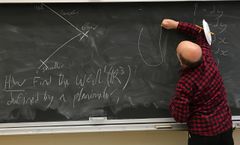1617-257/Homework Assignment 19: Difference between revisions
No edit summary |
(→Doing) |
||
| (One intermediate revision by one other user not shown) | |||
| Line 1: | Line 1: | ||
{{1617-257/Navigation}} |
{{1617-257/Navigation}} |
||
{{In Preparation}} |
|||
==Reading== |
==Reading== |
||
Read, reread and rereread your notes to this point, and make sure that you really, really really, really really really understand everything in them. Do the same every week! Also, read, reread and rereread sections 37-38 of Munkres' book to the same standard of understanding. Remember that reading math isn't like reading a novel! If you read a novel and miss a few details most likely you'll still understand the novel. But if you miss a few details in a math text, often you'll miss everything that follows. So reading math takes reading and rereading and rerereading and a lot of thought about what you've read. Also, preread section 39, just to get a feel for the future. |
Read, reread and rereread your notes to this point, and make sure that you really, really really, really really really understand everything in them. Do the same every week! Also, read, reread and rereread sections 37-38 of Munkres' book to the same standard of understanding. Remember that reading math isn't like reading a novel! If you read a novel and miss a few details most likely you'll still understand the novel. But if you miss a few details in a math text, often you'll miss everything that follows. So reading math takes reading and rereading and rerereading and a lot of thought about what you've read. Also, preread section 39, just to get a feel for the future. |
||
| Line 11: | Line 10: | ||
<b>Problem.</b> Why does a planimeter work? See images at {{Pensieve link|Classes/1617-257b-AnalysisII/Planimeter/|1617-257b-AnalysisII/Planimeter}}. |
<b>Problem.</b> Why does a planimeter work? See images at {{Pensieve link|Classes/1617-257b-AnalysisII/Planimeter/|1617-257b-AnalysisII/Planimeter}}. |
||
<b>NOTE:</b> To those of you who have a PDF of the textbook that might be outdated, there is a typo in problem 2a in section 37 in previous versions. The integral should read <math>\int\limits_{\partial M_1}^{}\left\langle G,N_1\right\rangle\text{d}V=\int\limits_{\partial M_2}^{}\left\langle G,N_2\right\rangle\text{d}V</math>. |
|||
==Submission== |
==Submission== |
||
Latest revision as of 13:02, 3 April 2017
Reading
Read, reread and rereread your notes to this point, and make sure that you really, really really, really really really understand everything in them. Do the same every week! Also, read, reread and rereread sections 37-38 of Munkres' book to the same standard of understanding. Remember that reading math isn't like reading a novel! If you read a novel and miss a few details most likely you'll still understand the novel. But if you miss a few details in a math text, often you'll miss everything that follows. So reading math takes reading and rereading and rerereading and a lot of thought about what you've read. Also, preread section 39, just to get a feel for the future.
Doing
Ponder the questions in sections 37 and 38, yet solve and submit only your solutions of problems 4, 5, and 6 in section 37 and problems 2, 3, and 5 in section 38.
Also ponder the following problem, but do not submit your thoughts:
Problem. Why does a planimeter work? See images at 1617-257b-AnalysisII/Planimeter.
NOTE: To those of you who have a PDF of the textbook that might be outdated, there is a typo in problem 2a in section 37 in previous versions. The integral should read .
Submission
Here and everywhere, neatness counts!! You may be brilliant and you may mean just the right things, but if the teaching assistants will be having hard time deciphering your work they will give up and assume it is wrong.
This assignment is due in class on Wednesday April 5 by 2:10PM.
Important
Please write on your assignment the day of the tutorial when you'd like to pick it up once it is marked (Wednesday or Thursday).



